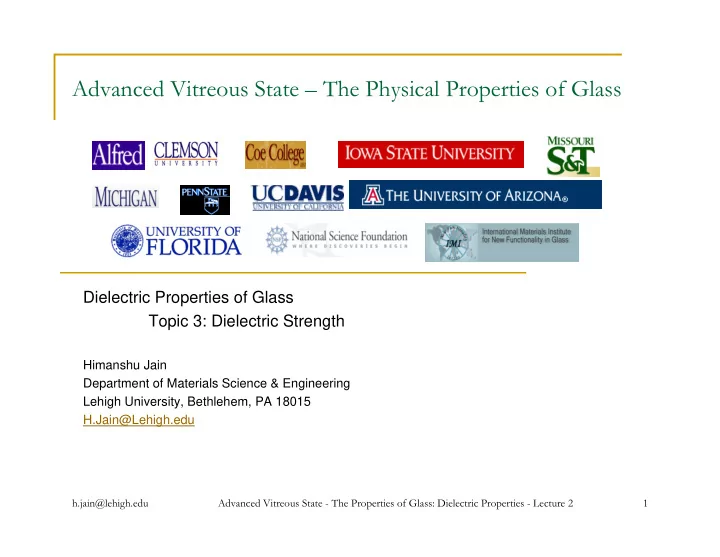

Advanced Vitreous State – The Physical Properties of Glass Dielectric Properties of Glass Topic 3: Dielectric Strength Himanshu Jain Department of Materials Science & Engineering Lehigh University, Bethlehem, PA 18015 H.Jain@Lehigh.edu h.jain@lehigh.edu Advanced Vitreous State - The Properties of Glass: Dielectric Properties - Lecture 2 1
Dielectric Breakdown – Dielectric Strength It is the highest electric field a dielectric can withstand without turning into a conductor: Dielectric strength = V breakdown / d (thickness) Common units: kV/mm or MV/cm or V/mil conductor The dielectric ceases to be useful I (amp) as an insulator at fields > D.S. insulator V b V (volt) 200,000 V across 2 cm thick insulator produces the same electrical stress as 20 V across a 2 μ m thick film ⇒ DS is very important in microelectronics, more than in high tension power lines. Also it determines the maximum laser power in glass fiber.
Dielectric strength is sample/technique dependent Besides temperature, DS may depend on: •Sample thickness •Ambient atmosphere •Electrode shape and composition •Surface finish •Field frequency and waveform •Composition, especially if it affects conductivity •Residual stresses •(porosity in the case of ceramics) h.jain@lehigh.edu Advanced Vitreous State - The Properties of Glass: Dielectric Properties – Topic 3 3 3
Intrinsic breakdown: A material property _ + Source of electrons: • - e • - e a.Injection from electrode • - e • - e • - e b.Thermal excitation across bandgap Action of accelerated electrons: • - e • - e a.Transfer energy to phonons i.e. raise T b.Eject additional electrons from atoms Breakdown occurs when average rate of energy gain A (field (E), lattice temp (T), energy of e (U)) > rate of energy loss to lattice B (T,U). A= e 2 E 2 τ (U,T)/m* and B is determined by the phonon spectrum of the solid. τ is mean collision time. Note that U has a distribution. Intrinsic breakdown occurs within 10 -8 – 10 -6 sec. - observed in high purity silica film grown on Si single crystal. h.jain@lehigh.edu Advanced Vitreous State - The Properties of Glass: Dielectric Properties – Topic 3 4
Max stress withstood by a range of inorganic thin films subjected to an increasing ramp of voltage. Straight lines have slope of ½. Fig. 5.11 of Batnikas & Eichorn. h.jain@lehigh.edu Advanced Vitreous State - The Properties of Glass: Dielectric Properties – Topic 3 5
Effect of T on intrinsic DS High uniformity and lack of defects is necessary to observe high intrinsic DS. In crystals: At very low T (<<RT): Scattering of e by phonons is weak, thus increasing the probability of ionization of atoms ⇒ lower DS At very high T (>>RT): Scattering of e by phonons is strong, but there is a greater number of e excited thermally across the bandgap ⇒ lower DS DS shows a peak around RT. In glasses: The e are scattered predominantly by the random structure ⇒ effect of T on DS is weak. Typically, 1-10 MV/cm h.jain@lehigh.edu Advanced Vitreous State - The Properties of Glass: Dielectric Properties – Topic 3 6
Thermal breakdown Electrical conductivity of glass ↑ , as T ↑ ⇒ increasing Joule heating that melts the solid locally and causes breakdown. Important in glasses with high conductivity, typically above RT. For breakdown: Joule heating > heat dissipated i.e. σ E 2 > [C v (dT/dt) + ∇• (K ∇ T)], where σ is electrical conductivity, E is electric field, C v is sp. heat and K is thermal conductivity. Solution of Eq. is difficult as σ and K are fn of T, and σ may also depend on E. Note that DS becomes thickness dependent. In ac field, heating is E 2 ωε 0 ε ”. Therefore, breakdown strength is frequency dependent, often being lower at higher frequencies. h.jain@lehigh.edu Advanced Vitreous State - The Properties of Glass: Dielectric Properties – Topic 3 7
Effect of T on Thermal Breakdown Cooling is assumed to follow Newton’s law. •At E 1 , breakdown is imminent. •At E 2 , unstable eqbm. at T 3 , as a small fluctuation of T will cause breakdown. •At E 3 , the eqbm. at T 2 is unstable – small fluctuation with T>T 2 ⇒ heating rate is higher than cooling rate ⇒ melt down. The eqbm. at T 1 is stable as T cannot continue to increase. Thermal lag, such as from encapsulation, decreases cooling and thus DS. When ambient T o ’ >T o , heat loss rate decreases and DS ↓ - A characteristic of thermal breakdown. h.jain@lehigh.edu Advanced Vitreous State - The Properties of Glass: Dielectric Properties – Topic 3 8
DS under pulsed field Intrinsic DS DS ↓ as pulse rise time ↑ due to build up of space charge from Na migration. The effect decreases at low T, where Na migration is negligible. J. Vermeer, Physica 20 (1954) 313 h.jain@lehigh.edu Advanced Vitreous State - The Properties of Glass: Dielectric Properties – Topic 3 9
Summary DS is very sensitive to sample history, quality and test conditions. Intrinsic DS is a material property, which may be observed at low T (below RT). For glasses, this type DS is nearly independent of T. Thermal breakdown from Joule heating dominates above RT, which is especially sensitive to defects, composition, duration of field, frequency, environment, electrodes, etc. h.jain@lehigh.edu Advanced Vitreous State - The Properties of Glass: Dielectric Properties – Topic 3 10
DS data from Internet – error in unit, MV/cm? Dielectric strength (MV/m??) of various common materials Material MV/m Air 3 Quartz 8 Strontium titanate 8 Neoprene rubber 12 Nylon 14 Pyrex glass 14 Silicone oil 15 Paper 16 Bakelite 24 Polystyrene 24 Teflon 60 http://www.answers.com/topic/dielectric-strength h.jain@lehigh.edu Advanced Vitreous State - The Properties of Glass: Dielectric Properties – Topic 3 11
Recommend
More recommend